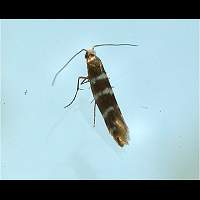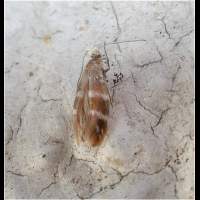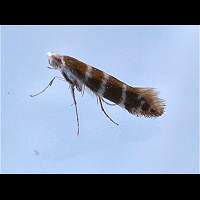Argyresthia trifasciata
The genus Argyresthia is comprised of at least 15 species in Britain. All species are very small indeed. Argyresthia trifasciata is a nice example. In the shadow it looks like a brownish species, but exposed to sunshine it turns out to glisten like it was made of gold. It has three striking white bands, running over the wings in rather straight lines. The scientific name is derived from these bands. Worn out animals, like the one in the picture in the middle are lighter, may have lost one or more bands and are more complicated to identify. The wingspan is some 7 to 9mm only.
The eggs are being laid in spring and early summer. Thay hatch by mid-June. The young larvae enter a leaf and eat this from the inside. They regularly move from one leaf to another. When almost fully grown they start mining young twigs. Inside the twig the larva overwinters. In March pupation takes place inside a cocoon spun on the outside of the stem of the foodplants. By May the first moths start appearing. The larvae are green. The head is black and the legs are brownish green. Known foodplants are conifers only: Junipers and Leyland Cypress. Especially in gardens these can be heavily infested with fresh leaves being hollow and getting brown.
Argyresthia trifasciata is single brooded and on the wing from May to the end of July. During the very warm spring in Holland of 2007, it already was numerous in April. Is easily attracted to light. Argyresthia trifasciata used to be an Alpine species. But due to the popularity of Conifers in garden it has spread northwards. First seen in both Holland and England (London) in 1982. Reached Sweden in 1993. Nowadays a locally common species over much of England, but expected to reach other parts of Britain in the near future.
The genus Argyresthia is comprised of at least 15 species in Britain. All species are very small indeed. Argyresthia trifasciata is a nice example. In the shadow it looks like a brownish species, but exposed to sunshine it turns out to glisten like it was made of gold. It has three striking white bands, running over the wings in rather straight lines. The scientific name is derived from these bands. Worn out animals, like the one in the picture in the middle are lighter, may have lost one or more bands and are more complicated to identify. The wingspan is some 7 to 9mm only.
The eggs are being laid in spring and early summer. Thay hatch by mid-June. The young larvae enter a leaf and eat this from the inside. They regularly move from one leaf to another. When almost fully grown they start mining young twigs. Inside the twig the larva overwinters. In March pupation takes place inside a cocoon spun on the outside of the stem of the foodplants. By May the first moths start appearing. The larvae are green. The head is black and the legs are brownish green. Known foodplants are conifers only: Junipers and Leyland Cypress. Especially in gardens these can be heavily infested with fresh leaves being hollow and getting brown.
Argyresthia trifasciata is single brooded and on the wing from May to the end of July. During the very warm spring in Holland of 2007, it already was numerous in April. Is easily attracted to light. Argyresthia trifasciata used to be an Alpine species. But due to the popularity of Conifers in garden it has spread northwards. First seen in both Holland and England (London) in 1982. Reached Sweden in 1993. Nowadays a locally common species over much of England, but expected to reach other parts of Britain in the near future.






